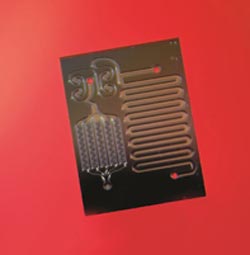Medical diagnostics: Identifying viruses on the spot

A silicon-based viral extraction chip developed at the A*STAR Institute of Microelectronics. © 2012 Chris Gilloch<br>
Dengue fever is a disease passed to humans by mosquitoes. Millions of people every year are infected worldwide, and around 4,000–5,000 of these cases will suffer severe complications or death. Dengue fever most commonly affects young people between the ages of 15 and 24.
Currently, doctors identify dengue fever by clinical observations followed by a series of laboratory tests of blood and urine samples. These tests can take seven to ten days to complete, and require highly skilled staff and specialist equipment. Due to the complexity of the process, there is also a chance of cross-contamination during the procedure.
For these reasons, researchers are keen to develop quicker, more accurate ways of identifying viruses such as dengue fever. Siti Mohamed Rafei and co-workers at A*STAR’s Institute of Microelectronics, together with scientists from Veredus Laboratories in Singapore and the National University of Singapore, have designed and built a new self-contained microsystem that can ascertain the presence of dengue fever in blood samples within 30 minutes. Crucially, the new cartridge can be operated by non-skilled staff.
The microsystem works by extracting viral RNA from patients’ blood samples. Using a silicon-based viral extraction chip, and a cartridge containing reservoirs pre-filled with the different reagents required to extract viral RNA, the microsystem is fully self-contained.
In conventional virus detection systems, the chance of cross contamination is high because the extraction process requires extensive manual pipetting of reagents. In the newly designed system, the silicon chip is embedded in a polymeric cartridge that allows the user to preload all necessary reagents, making it fully self-contained and disposable. This added feature is extremely useful for testing infectious disease that might be highly virulent or contagious.
The cartridge is placed inside a handheld computer device with a touch screen. Pressing the start button operates a pre-determined series of plungers, which release the reagents into the silicon chip containing the blood sample. The reagents allow for the extraction of viral RNA and virus identification readout within 30 minutes.
The sequence of plungers and their speed are fully computer-controlled, thus the cartridge is configurable, user-friendly and does not require specialist knowledge to operate. In addition, the cartridge is adaptable to multiple biochemical protocols, not just to the viral RNA for dengue fever as described here. In future, the researchers hope to identify many infectious diseases with this technology.
The A*STAR-affiliated researchers contributing to this research are from the Institute of Microelectronics
References:
Zhang, L. et al. A self-contained disposable cartridge microsystem for dengue viral ribonucleic acid extraction. Sensors and Actuators B: Chemical 160, 1557–1564 (2011).
Media Contact
All latest news from the category: Health and Medicine
This subject area encompasses research and studies in the field of human medicine.
Among the wide-ranging list of topics covered here are anesthesiology, anatomy, surgery, human genetics, hygiene and environmental medicine, internal medicine, neurology, pharmacology, physiology, urology and dental medicine.
Newest articles

A universal framework for spatial biology
SpatialData is a freely accessible tool to unify and integrate data from different omics technologies accounting for spatial information, which can provide holistic insights into health and disease. Biological processes…

How complex biological processes arise
A $20 million grant from the U.S. National Science Foundation (NSF) will support the establishment and operation of the National Synthesis Center for Emergence in the Molecular and Cellular Sciences (NCEMS) at…

Airborne single-photon lidar system achieves high-resolution 3D imaging
Compact, low-power system opens doors for photon-efficient drone and satellite-based environmental monitoring and mapping. Researchers have developed a compact and lightweight single-photon airborne lidar system that can acquire high-resolution 3D…





















